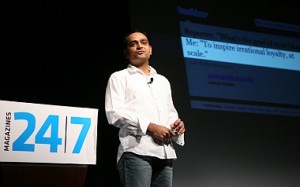 You have to love a keynote speaker who shows up in a button down and jeans. I wish I had the cajones to do that! Avinash Kaushik, author, speaker, analytics evangelist, and Google pro, began his speech by talking about his blog Occam’s Razor by saying, “It brainwashes you into thinking like I do.”
You have to love a keynote speaker who shows up in a button down and jeans. I wish I had the cajones to do that! Avinash Kaushik, author, speaker, analytics evangelist, and Google pro, began his speech by talking about his blog Occam’s Razor by saying, “It brainwashes you into thinking like I do.”
If you don’t know Avinash, he is the author of “Web Analytics: An Hour A Day” and “Web Analytics 2.0”. He has a great sense of humor, which comes through when he talks about his books. He relays that Wiley & Sons approached him about writing a book about his blog. He said he couldn’t understand why anyone would pay for content that is already free on the blog. But, he learned after his first book was translated into several languages, “People like paying for free things all around the world!”
Following are the takeaways from both Molli and me.
Look beyond the basic dashboard analytics. Look beyond the 10 rows of data that your brain can take in so you can see your search trends. You can do that by analyzing your keywords to find where you “suck” (see next key takeaway).
There are free tools to figure out where your SEO stands right now. Go to Wordle right now and type in “www.spinsucks.com” to the URL block. You’ll see we do a fairly nice job with SEO because all of the things we discuss here come up in the tag cloud (i.e. Twitter, Facebook, share, content, value, etc.). Now go back and type in your company name or your blog’s URL. What comes up in the tag cloud? How is your organic search?
If half of your traffic isn’t coming from search, you’re not doing something right. You don’t need to pay for search until after you’ve generated enough traffic to create the long tail. Pay-per-click (PPC) should be unleashed at the middle of the tail, not at the head. At the head, half of your Web and/or blog traffic should be coming from organic search, which happens through both search engine optimization and social media marketing.
Set goals and measure them. Yes, it is important to measure conversions, but if only two percent translate to your goals, it is important to focus on the other 98 percent. Don’t focus on basic items, figure out why you have a blog or what you want to achieve (in terms of sales) from your site. Create goals that move beyond sales and conversions – i.e. reading certain pages or gaining subscribers. Setting up goals gives you economic value and help you achieve greatness on the Web.
Convincing the boss is more than showing how many visitors are coming to the site. For instance, how many visits does it take for someone to convert on your Web site or blog? In any of the analytics tools you use (Google, Omniture, etc.), and if you have goals set up for conversion rates, you can run a report to answer that question. If it’s within one to five visits, you’re doing really well. If it’s more than five visits, some changes need to be made or, as Avinash says, “You can freak and cry like a little girl.”